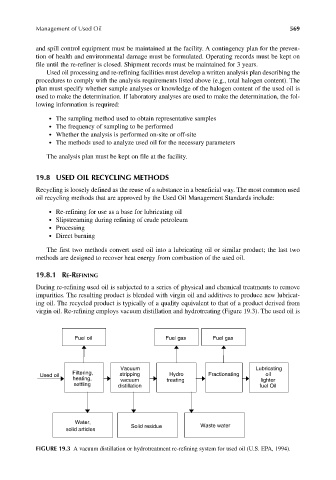Page 598 - Materials Chemistry, Second Edition
P. 598
CAT3525_C19.qxd 1/28/2005 5:05 PM Page 569
Management of Used Oil 569
and spill control equipment must be maintained at the facility. A contingency plan for the preven-
tion of health and environmental damage must be formulated. Operating records must be kept on
file until the re-refiner is closed. Shipment records must be maintained for 3 years.
Used oil processing and re-refining facilities must develop a written analysis plan describing the
procedures to comply with the analysis requirements listed above (e.g., total halogen content). The
plan must specify whether sample analyses or knowledge of the halogen content of the used oil is
used to make the determination. If laboratory analyses are used to make the determination, the fol-
lowing information is required:
● The sampling method used to obtain representative samples
● The frequency of sampling to be performed
● Whether the analysis is performed on-site or off-site
● The methods used to analyze used oil for the necessary parameters
The analysis plan must be kept on file at the facility.
19.8 USED OIL RECYCLING METHODS
Recycling is loosely defined as the reuse of a substance in a beneficial way. The most common used
oil recycling methods that are approved by the Used Oil Management Standards include:
● Re-refining for use as a base for lubricating oil
● Slipstreaming during refining of crude petroleum
● Processing
● Direct burning
The first two methods convert used oil into a lubricating oil or similar product; the last two
methods are designed to recover heat energy from combustion of the used oil.
19.8.1 RE-REFINING
During re-refining used oil is subjected to a series of physical and chemical treatments to remove
impurities. The resulting product is blended with virgin oil and additives to produce new lubricat-
ing oil. The recycled product is typically of a quality equivalent to that of a product derived from
virgin oil. Re-refining employs vacuum distillation and hydrotreating (Figure 19.3). The used oil is
Fuel oil Fuel gas Fuel gas
Vacuum Lubricating
Filtering,
Used oil stripping Hydro Fractionating oil
heating, vacuum treating lighter
settling distillation fuel Oil
Water,
Solid residue Waste water
solid articles
FIGURE 19.3 A vacuum distillation or hydrotreatment re-refining system for used oil (U.S. EPA, 1994).

